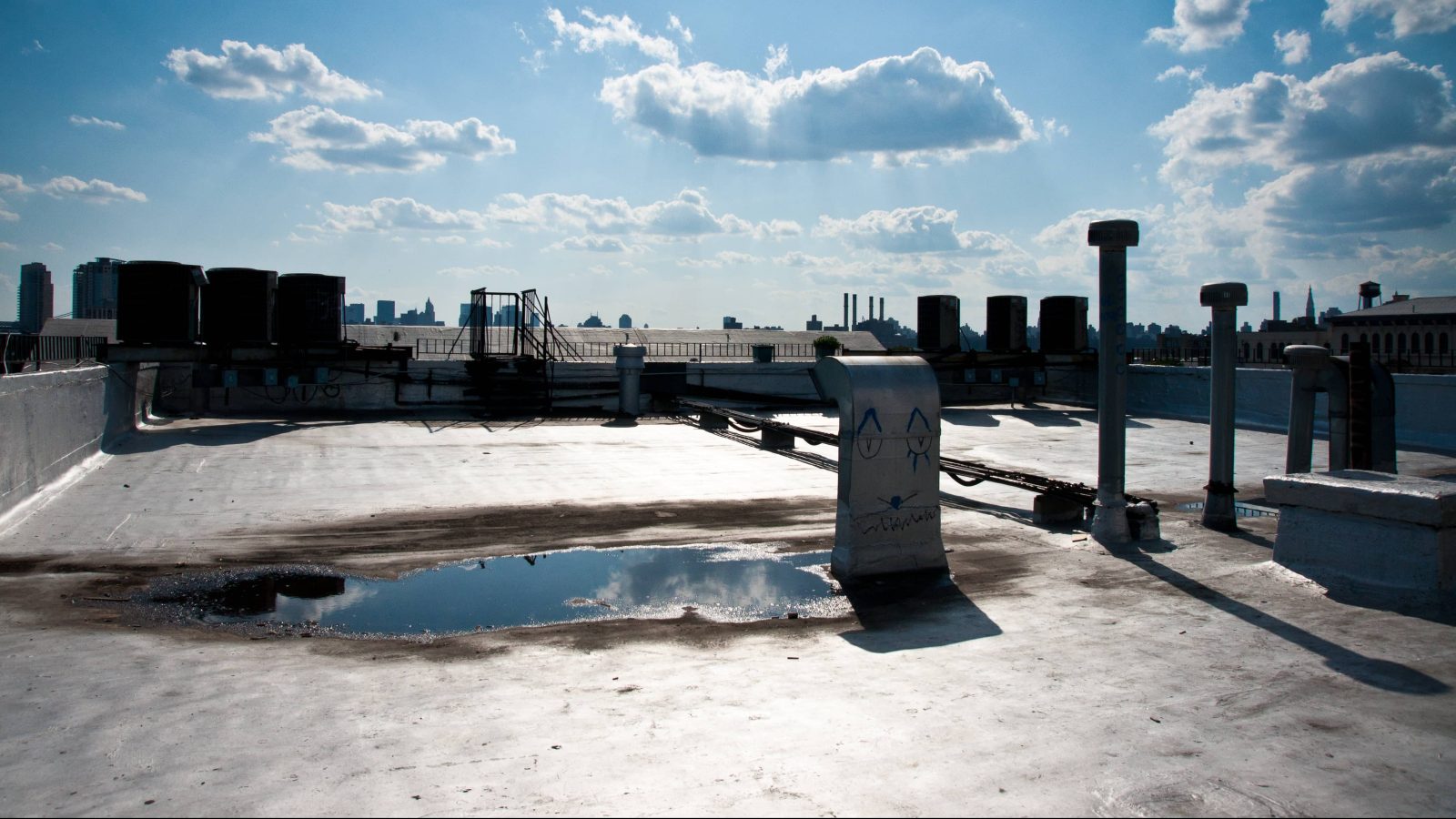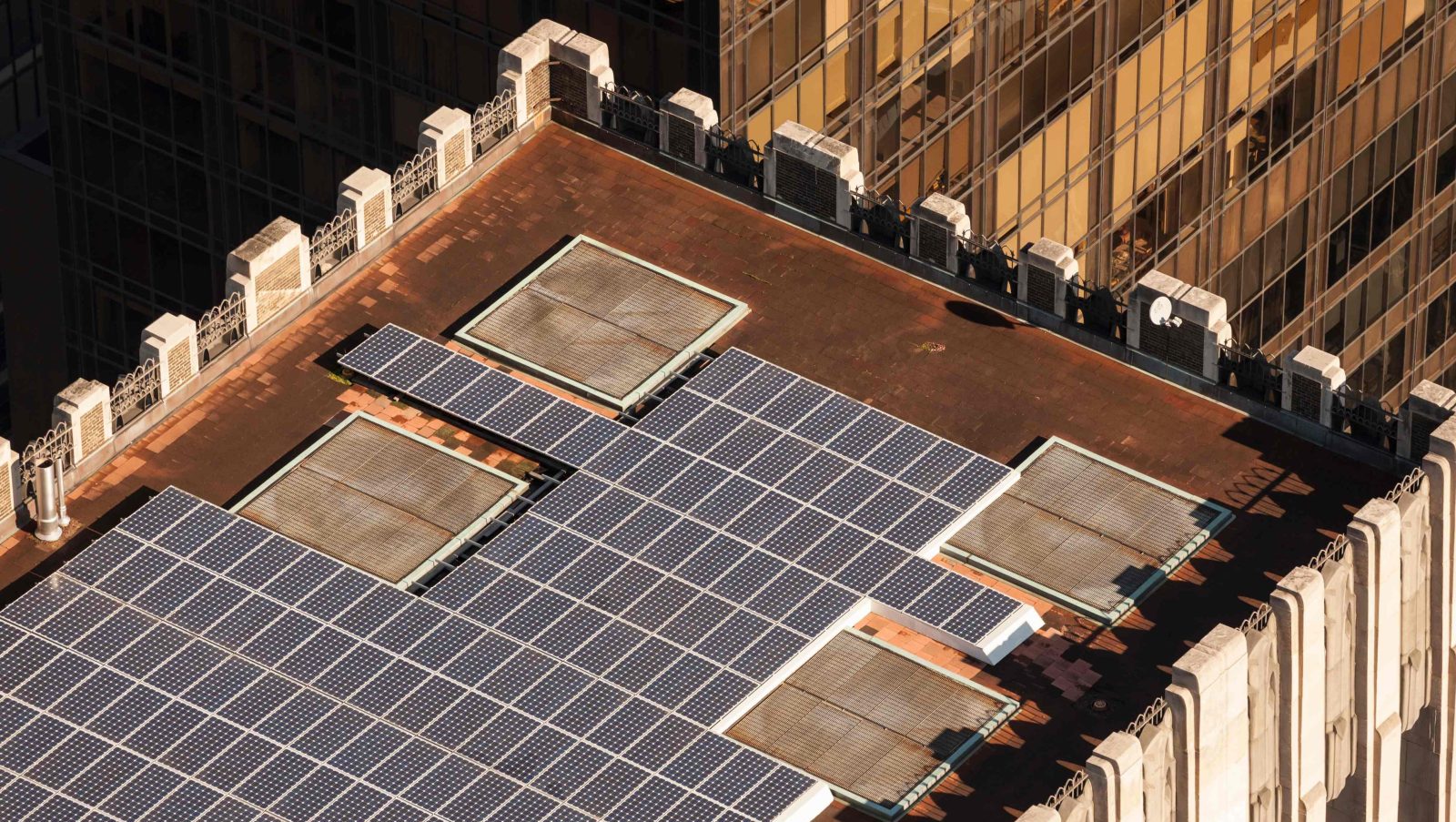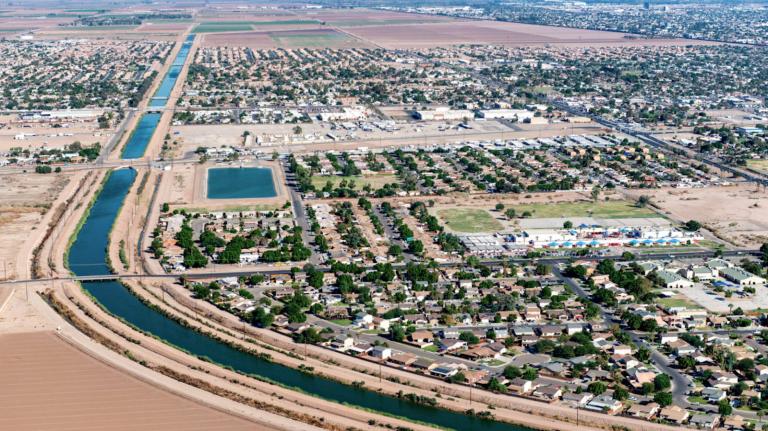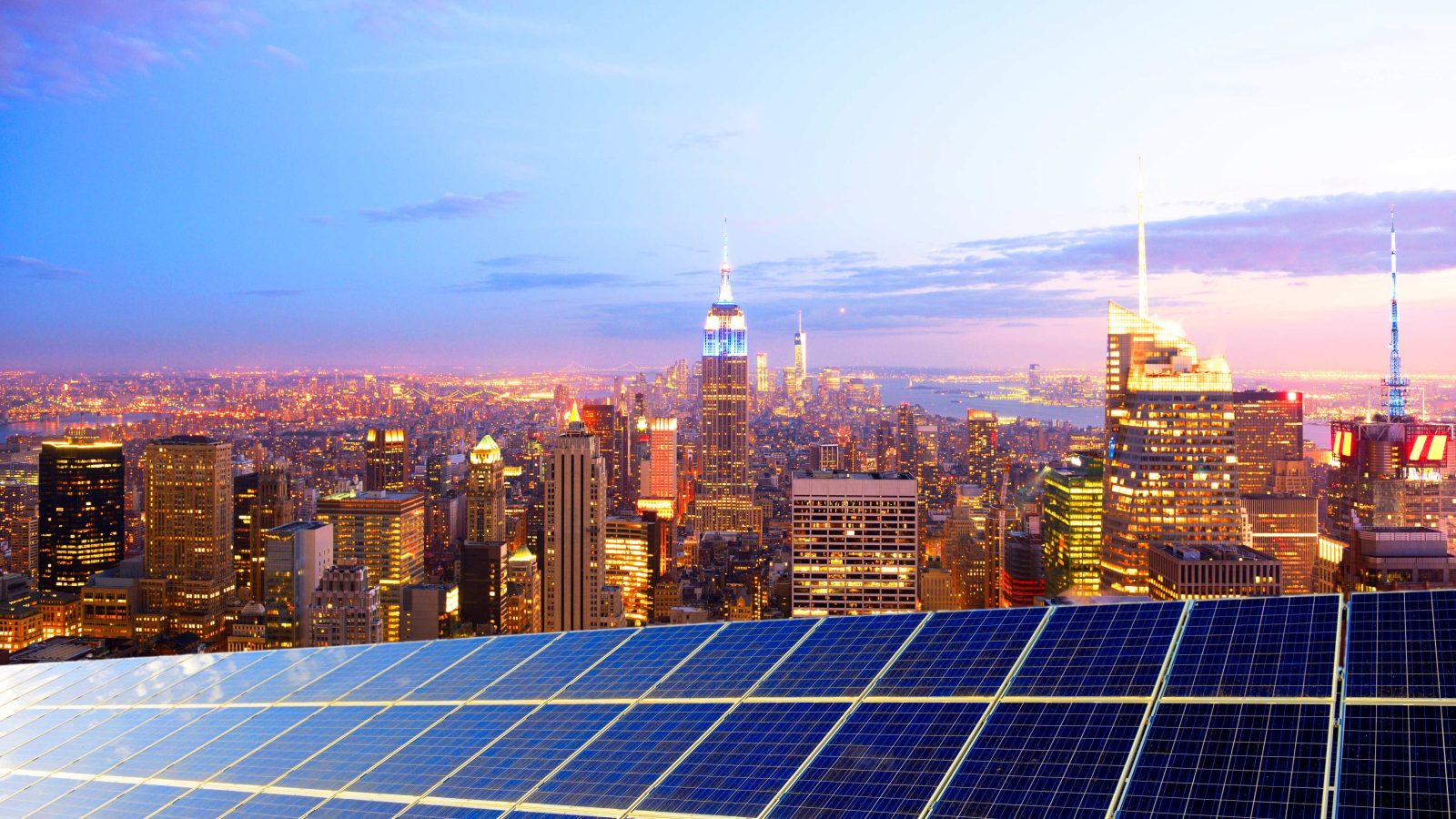In 2014, former Mayor Bill de Blasio’s office announced an ambitious new climate target: 80 percent fewer emissions city wide by 2050. In order to reach that goal, the city aims to install 1,000 megawatts of solar technology within the five boroughs by 2030, enough to supply 250,000 homes with electricity.
But New York City has fallen behind. As of April, it had only installed 333 megawatts of solar — less than half of the solar capacity it aims to achieve by the end of this decade. NYC has a 70 megawatt solar gap to close this year alone in order to fulfill its 2030 goal.
A number of regulatory hurdles stand in the way of the city making progress on its climate ambitions. One of those obstacles can be found in a surprising place: New York City’s fire and building codes.
In a city as densely populated as New York, rooftops play an essential role in deploying renewable energy. Without rooftop solar, the city can’t install enough solar capacity to meet its climate goal. City leaders know this — as of 2019, the city requires all new buildings and major renovations of existing buildings to include either solar panels or a green roof system. But putting a solar installation on every rooftop in the city isn’t easy — and especially on the rooftops of existing buildings. Solar panels are clunky objects that have to share space with bulkheads — structures on roofs that cover water tanks, shafts, or service equipment — mechanical equipment, stairways, railings, emergency pathways and exits, and more.

The New York City Fire Department’s, or FDNY’s, fire code seeks to balance the long list of items, including solar panels, on NYC’s rooftops with the agency’s primary firefighting efforts. Firefighters often access rooftops to vent smoke from burning structures, perform rescue operations, and put out fires before they spread to neighboring buildings, and they need clear paths to do it.
The code “balances requirements that are fair to all industries, while also maintaining safety,” a spokesperson for the FDNY told Grist. But solar industry experts say the FDNY’s code, one of the strictest in the nation, isn’t fair to solar companies and sidelines the city’s goal of reaching 1,000 megawatts of solar capacity by 2030 by unnecessarily squeezing the amount of panels that can go on a rooftop. “They’re constantly trying to encroach on the usable rooftop,” T.R. Ludwig, CEO of an NYC-based solar company called Brooklyn Solarworks, told Grist.
A revision to the fire code that took place at the end of last year is at the heart of New York’s solar industry’s beef with the FDNY. In December 2021, after seeking input from the public and various industries within the city, the FDNY revised its 2014 fire code, and the city council voted to approve it. The updated code said that new buildings constructed in New York City would have to comply with even stricter safety requirements around rooftop solar — more access pathways around panels and railings around rooftops that have solar on them. Ludwig, the CEO of Brooklyn Solarworks, wasn’t thrilled about the change. “But we kind of gave in on that particular point,” he said, “if it was new construction.”
Pretty soon, however, Ludwig noticed that the FDNY’s rooftop enforcement unit, a different unit from the one that had written the initial revision to the code, had interpreted the revision differently. It appeared as though that unit saw the code as requiring all buildings, not just new ones, to adhere to the updated safety requirements. The Department of Buildings, the agency that approves or denies building permits in the city based, in part, on whether a given work permit adheres to the fire code, seemed to interpret the FDNY’s revisions in a similar way and, in addition, now viewed solar panels as “serviceable equipment.” That triggers a new set of requirements for railings around the installations, which further squeeze the amount of rooftop space and cast shadows on the panels, making them less efficient. All of a sudden, Brooklyn Solarworks’ plan sets for solar installations on existing buildings, plans that Ludwig says would have likely had no problem getting the green light before the revision to the fire code, started getting rejected.
Ludwig provided Grist with 13 examples of new Brooklyn Solarworks installations on existing buildings that had failed to pass inspection because they didn’t comply with the revision to the fire code. “There’s been no communication with the industry. There’s been no public forum,” he said. “One decision has been made that’s going to cause a pretty serious ripple effect on solar system sizes, solar system production, and the cost.”
Ludwig estimates that adding more pathways and railings around solar installations, in line with what the fire code and the Department of Buildings have been calling for, adds between $5,000 and $8,000 to the cost of a given project — a cost increase of between 10 and 20 percent. “That just seems counter to what New York City is striving for in terms of renewable energy deployment,” Ludwig said.
The FDNY sees things differently. “The FDNY’s Code dealing with Rooftop Access requirements is not and has never been retroactive,” the FDNY spokesperson said. “Rooftops existing in a legal state prior to the enactment of the 2022 code do not have to be brought into full compliance with the new requirements unless work is being done.” The problem is that the FDNY now sees solar panel installation as “work,” and the solar industry does not. “That’s really the crux of it there,” Ludwig said. “If there’s a new building or someone is tearing off the top level of a building and putting in a roofdeck with a building permit, then sure. But the fact that they’re coming back and saying solar is part of this, that’s not what we agreed on.”

The FDNY spokesperson told Grist that “ALL work done on a rooftop that doesn’t fall under the category of repairs” triggers the new code requirements. As far as Ludwig is concerned, that contradicts what the industry understood the new code to mean when it was passed. “We do feel burned,” he said.
There is a way around the new requirements. Companies can apply for a variance — a permit from the FDNY that allows a rooftop project to skirt a fire code requirement. Veronica Ciechowska Polanco, a project manager at commercial real estate inspection company Burnham who often applies for solar permits for commercial and residential buildings, said that when she runs into an issue with the fire code, she applies for a variance. “That’s just another additional application with FDNY that they kind of treat case by case,” she said. Ludwig pointed out that applying for a variance costs $420 and can add weeks to a process that’s already complex and time-consuming. Plus, in his experience, the FDNY hasn’t been amenable to variances around making access pathways narrower or eliminating railings in his experience. “What we’ve seen is they’re not terribly open to variances,” he said.
Ludwig’s frustration with the FDNY’s fire code illuminates an underrated challenge in the city’s quest to decarbonize: NYC’s efforts to equip rooftops with solar panels are being slowed not by technological feasibility or even a lack of climate ambition on the part of city government. The issue comes down to a somewhat mundane conversation about how code should be interpreted. On one side, you have the city’s solar industry, which believes the code should encourage solar installation, not hamper it. On the other, the FDNY maintains that the fire code’s chief priority is to protect the public and its firefighters.
“When you talk to anyone at any of these agencies, what they say is they’re very supportive of clean energy and climate goals,” Joe Lipari, who oversees permitting for rooftop solar installations at Brooklyn Solarworks, told Grist. “But the devil’s really in the details. There are bureaucratic hurdles they’ve proposed that introduce significant challenges that, frankly at this point in the climate crisis, I don’t think anyone needs to be dealing with.”
Ben Furnas, who served as director of the New York City Mayor’s Office of Climate and Sustainability under de Blasio, told Grist that the task of balancing those two priorities doesn’t necessarily fall on solar companies or the FDNY; it should be shouldered by the elected officials who are responsible for meeting the city’s climate goal. Right now, that means both the city council and the administration of Eric Adams, who was sworn in as mayor in January and who oversees both the FDNY and the Department of Buildings.
“I think this is an opportunity for folks in the administration now to be making sure that the fire code and the building code are aligned with the imperative of confronting climate change, recognizing that these aren’t easy tradeoffs,” Furnas said. “These are really serious issues with really important goals you’re trying to achieve on both sides and balancing it is sort of the job of elected officials and folks in government.”
Balancing public safety and climate action was something Furnas focused on during his time in the de Blasio administration. “We carried the torch for the city’s solar goals,” he said. Adams will have to do the same if the city is to meet its targets. “The fire code is just a piece of legislation,” Furnas said, and the city council “is well within their rights to make adjustments based on what they see as the appropriate way of balancing these different things. And I think similarly, the mayor and folks in the mayor’s office can be striking this balance.”
The mayor’s office seems to have taken some of the criticism into consideration. In response to a request for comment from Grist, Rachel Finkelstein, a senior policy advisor for the NYC Mayor’s Office of Climate and Environmental Justice, which oversees the city’s climate change efforts, said that the Department of Buildings has reconsidered its view of solar panels as serviceable equipment. “After conversations with stakeholders,” Finkelstein said, the Department of Buildings “no longer interprets this section of Code as requiring railings for solar installations.” The fire code remains unchanged.



